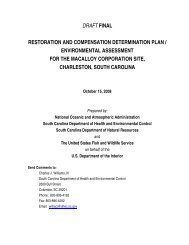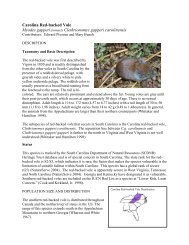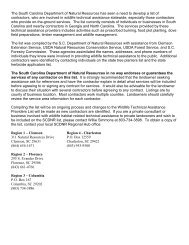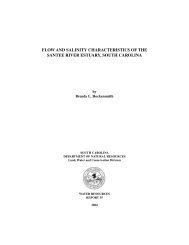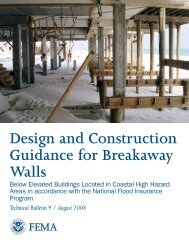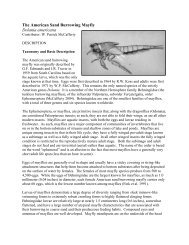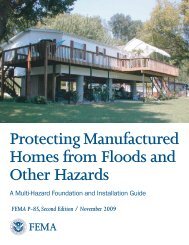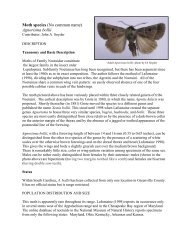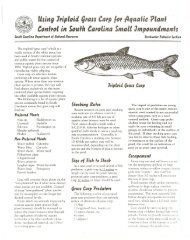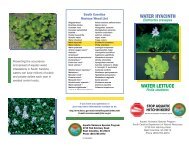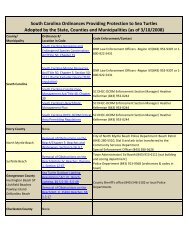Coastal Building Materials - Anthony Forest Products Co.
Coastal Building Materials - Anthony Forest Products Co.
Coastal Building Materials - Anthony Forest Products Co.
You also want an ePaper? Increase the reach of your titles
YUMPU automatically turns print PDFs into web optimized ePapers that Google loves.
<strong><strong>Co</strong>astal</strong> <strong>Building</strong><br />
<strong>Materials</strong><br />
HOME BUILDER’S GUIDE TO COASTAL CONSTRUCTION FEMA 499/August 2005 Technical Fact Sheet No. 8<br />
Purpose: To provide guidance on the selection of building materials used for coastal construction.<br />
Key Issues<br />
• The durability of a coastal home relies on the types of materials used to construct it. For more details,<br />
see the U.S. Department of Housing and Urban Development (HUD) report Durability by Design, A Guide for<br />
Residential Builders and Designers, available on the HUD User website at<br />
http://www.huduser.org/publications/destech/durdesign.html.<br />
• <strong>Materials</strong> and construction methods should be resistant to flood and wind damage, driving rain, corrosion,<br />
moisture, and decay.<br />
• All coastal buildings will require maintenance and repairs (more so than inland construction) — use proper<br />
materials and methods for repairs, additions, and other work following initial construction (see Fact Sheet No. 30).<br />
Section 60.3(a)(ii) of the National Flood Insurance Program (NFIP) regulations requires that all new construction and<br />
substantial improvements in floodprone areas be constructed with materials below the Base Flood Elevation (BFE)<br />
that are resistant to flood damage. (See Fact Sheet No. 30 for a definition of “substantial improvement.”)<br />
Flood-Resistant <strong>Materials</strong><br />
Flooding accounts for a large percentage of the damage caused by a coastal storm. <strong>Building</strong> materials<br />
exposed to flooding must be resilient enough to sustain a certain amount of water exposure in order to avoid<br />
the need for complete replacement after the flood.<br />
FEMA defines a flood-resistant<br />
material as any building<br />
material capable of withstanding<br />
direct and prolonged contact<br />
(i.e., at least 72 hours) with<br />
floodwaters without sustaining<br />
significant damage (i.e., requires<br />
more than cosmetic repair).<br />
The following are examples of<br />
flood-resistant materials:<br />
• Lumber: pressure-treated<br />
or naturally decay-resistant,<br />
including redwood, cedar,<br />
some oaks, and bald cypress<br />
• <strong>Co</strong>ncrete: a sound, durable<br />
mix, and when exposed<br />
to saltwater or salt spray,<br />
made with a sulfate-resisting<br />
cement, with a 28-day<br />
compressive strength of<br />
Select building materials that can endure periodic flooding.<br />
FS No. 8 – <strong><strong>Co</strong>astal</strong> <strong>Building</strong> <strong>Materials</strong> Home Builder’s Guide to <strong><strong>Co</strong>astal</strong> <strong>Co</strong>nstruction 08/05 Page 1 of 5
5,000 psi minimum and a water-cement ratio not higher than 0.40 – consult ACI 318-02, <strong>Building</strong> <strong>Co</strong>de<br />
Requirements for Structural <strong>Co</strong>ncrete and <strong>Co</strong>mmentary, by the American <strong>Co</strong>ncrete Institute International<br />
• Masonry: reinforced and fully grouted<br />
• Structural Steel: coated to resist corrosion<br />
• Insulation: plastics, synthetics, and closed-cell foam, or other types approved by local building officials<br />
This table lists examples of flood-resistant materials used in coastal homes.<br />
FS No. 8 – <strong><strong>Co</strong>astal</strong> <strong>Building</strong> <strong>Materials</strong> Home Builder’s Guide to <strong><strong>Co</strong>astal</strong> <strong>Co</strong>nstruction 08/05<br />
Page 2 of 5
Many coastal jurisdictions make available a list of approved materials that can be used in coastal environments.<br />
Check for locally approved flood-resistant materials. Include all proposed construction and materials in approved<br />
plans. For guidance on testing specific materials, refer to NES Evaluation Protocol for Determination of Flood-<br />
Resistant Properties of <strong>Building</strong> Elements (NES, Inc. – http://www.nateval.org).<br />
Wind-Resistant <strong>Materials</strong><br />
Homes in many coastal areas are often exposed to<br />
winds in excess of 90 mph (3-second peak gust).<br />
Choose building materials (e.g., roof shingles, siding,<br />
windows, doors, fasteners, and framing members) that<br />
are designed for use in high-wind areas.<br />
Examples:<br />
• shingles rated for high winds (see Fact Sheet No. 20)<br />
• double-hemmed vinyl siding (see Fact Sheet No. 25)<br />
• deformed-shank nails for sheathing attachments<br />
(see Fact Sheet No. 18)<br />
• wind-resistant glazing (see Fact Sheet No. 22)<br />
• reinforced garage doors<br />
• tie-down connectors used throughout structure (from roof<br />
framing to foundation — see Fact Sheet Nos. 10 and 17)<br />
• wider framing members (2x6 instead of 2x4)<br />
Remember: A wind-resistant material is<br />
only as good as its connection. Always use<br />
recommended fasteners and connection<br />
methods.<br />
<strong>Co</strong>rrosion and Decay Resistance<br />
<strong><strong>Co</strong>astal</strong> environments are conducive to metal corrosion<br />
and moisture- and termite-related decay of other<br />
building materials. Metal corrosion is most pronounced<br />
on coastal homes (within 3,000 feet of the ocean),<br />
but moisture- and termite-related decay are prevalent<br />
throughout coastal areas.<br />
<strong>Co</strong>rrosion-Resistant Metals<br />
Most jurisdictions require metal building hardware to<br />
be hot-dipped galvanized or stainless steel. Some local<br />
codes require protective coatings that are thicker than<br />
“off-the-shelf” products typically have. For example,<br />
a G90 zinc coating (0.75 mil on each face) may be<br />
required, which is thicker than the common G60 (0.5<br />
mil on each face) coating.<br />
Recommendations<br />
• Use hot-dipped galvanized or stainless steel hardware.<br />
Reinforcing steel should be protected from corrosion<br />
by sound materials (masonry, mortar, grout, concrete)<br />
and good workmanship (see Fact Sheet No. 16). Use<br />
Select building materials that are suitable for the<br />
expected wind forces.<br />
The term "corrosion-resistant" is widely used<br />
but, by itself, is of little help to those specifying<br />
or evaluating materials for use in a coastal<br />
home. Every material resists corrosion to some<br />
extent, or conversely, every material corrodes.<br />
The real issue is how long will a given material<br />
serve its intended purpose at a given home?<br />
The answer depends on the following:<br />
• the material<br />
• where it is used in the home<br />
• whether installation techniques (e.g., drilling,<br />
cutting, bending) will compromise its resistance<br />
• its degree of exposure to salt air, moisture,<br />
and corrosive agents<br />
• whether maintenance required of the<br />
homeowner is performed<br />
The bottom line: do not blindly specify or<br />
accept a product just because it is labeled<br />
corrosion-resistant. Evaluate the nature of<br />
the material, its coating type and thickness<br />
(if applicable), and its performance in similar<br />
environments before determining whether it is<br />
suitable for a particular application.<br />
For guidance on the selection of metal hardware<br />
for use in coastal environments, consult<br />
an engineer with experience in corrosion protection.<br />
For more information about corrosion<br />
in coastal environments, see FEMA Technical<br />
Bulletin 8-96, <strong>Co</strong>rrosion Protection for Metal<br />
<strong>Co</strong>nnectors in <strong><strong>Co</strong>astal</strong> Areas for Structures<br />
Located in Special Flood Hazard Areas (see the<br />
Additional Resources section of this fact sheet).<br />
FS No. 8 – <strong><strong>Co</strong>astal</strong> <strong>Building</strong> <strong>Materials</strong> Home Builder’s Guide to <strong><strong>Co</strong>astal</strong> <strong>Co</strong>nstruction 08/05 Page 3 of 5
galvanized or epoxy-coated reinforcing steel in situations where the potential for corrosion is high (see Fact<br />
Sheet No. 14).<br />
• Avoid joining dissimilar metals, especially those with<br />
high galvanic potential (e.g., copper and steel).<br />
• Some wood preservatives should not be used in<br />
direct contact with galvanized metal. Verify that wood<br />
treatment is suitable for use with galvanized metal, or<br />
use stainless steel.<br />
• Metal-plate-connected trusses should not be exposed<br />
to the elements. Truss joints near vent openings<br />
are more susceptible to corrosion and may require<br />
increased corrosion protection.<br />
Moisture Resistance<br />
<strong>Materials</strong> resistant to moisture can greatly reduce<br />
maintenance and extend the life of a coastal home<br />
(however, by themselves, such materials cannot<br />
prevent all moisture damage. Proper design and<br />
installation of moisture barriers (see Fact Sheet No. 9)<br />
is also required).<br />
Recommendations<br />
• <strong>Co</strong>ntrol wood decay by separating wood from moisture,<br />
using preservative-treated wood, using naturally decayresistant<br />
wood, and applying protective wood finishes.<br />
• Use proper detailing of wood joints and construction<br />
to eliminate standing water and reduce moisture<br />
absorption by the wood (e.g., avoid exposure of end<br />
grain cuts, which absorb moisture up to 30 times<br />
faster than the sides of a wood member).<br />
• Do not use untreated wood in ground contact or highmoisture<br />
situations. Do not use untreated wood in<br />
direct contact with concrete.<br />
• Field-treat any cuts or drill holes that offer paths for<br />
moisture to enter wood members.<br />
• For structural uses, employ concrete that is sound,<br />
dense, and durable; control cracks with welded wire<br />
fabric and/or reinforcing, as appropriate.<br />
• Use masonry, mortar, and grout that conform with the<br />
latest building codes.<br />
Metals corrode at a much faster rate near the ocean.<br />
Always use well-protected hardware, such as this<br />
connector with thick galvanizing. (For information about<br />
pile-to-beam connections, see Fact Sheet No. 13).<br />
Termite Resistance<br />
Termite damage to wood construction occurs in many<br />
coastal areas (attack is most frequent and severe along<br />
the southeastern Atlantic and Gulf of Mexico shorelines,<br />
in California, and in Hawaii and other tropical areas).<br />
Termites can be controlled by soil treatment, termite<br />
shields, and the use of termite-resistant materials.<br />
Wood decay at the base of a wood<br />
post supported by concrete.<br />
FS No. 8 – <strong><strong>Co</strong>astal</strong> <strong>Building</strong> <strong>Materials</strong> Home Builder’s Guide to <strong><strong>Co</strong>astal</strong> <strong>Co</strong>nstruction 08/05<br />
Page 4 of 5
Recommendations<br />
• Incorporate termite control methods into design in conformance with requirements of the authority having<br />
jurisdiction.<br />
• Where a masonry foundation is used and anchorage to the foundation is required for uplift resistance, the<br />
upper block cores must usually be completely filled with grout, which may eliminate the requirement for<br />
termite shields (see Fact Sheet No. 14).<br />
• Use preservative-treated wood for foundations, sills, above-foundation elements, and floor framing.<br />
Additional Resources<br />
FEMA. NFIP Technical Bulletin 2-93, Flood-Resistant <strong>Materials</strong> Requirements for <strong>Building</strong>s Located in Special<br />
Flood Hazard Areas. (http://www.fema.gov/fima/techbul.shtm)<br />
FEMA. NFIP Technical Bulletin 8-96, <strong>Co</strong>rrosion Protection for Metal <strong>Co</strong>nnectors in <strong><strong>Co</strong>astal</strong> Areas for Structures<br />
Located in Special Flood Hazard Areas. (http://www.fema.gov/fima/techbul.shtm)<br />
American <strong>Co</strong>ncrete Institute International. (http://www.aci-int.org/general/home.asp)<br />
American Wood-Preservers’ Association. (http://www.awpa.com)<br />
International <strong>Co</strong>de <strong>Co</strong>uncil Evaluation Service, Inc. Protocol for Testing the Flood Resistance of <strong>Materials</strong>.<br />
(http://www.icc-es.org/index.shtml)<br />
FS No. 8 – <strong><strong>Co</strong>astal</strong> <strong>Building</strong> <strong>Materials</strong> Home Builder’s Guide to <strong><strong>Co</strong>astal</strong> <strong>Co</strong>nstruction 08/05 Page 5 of 5



